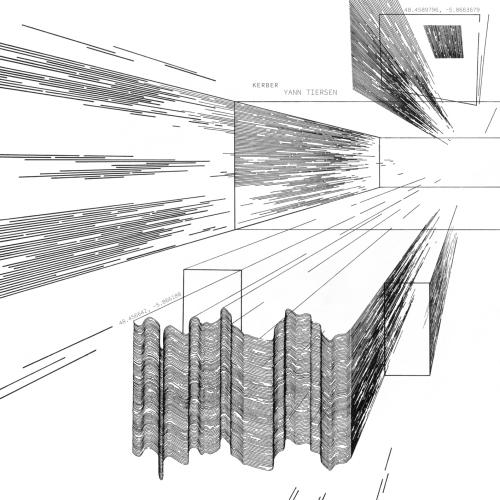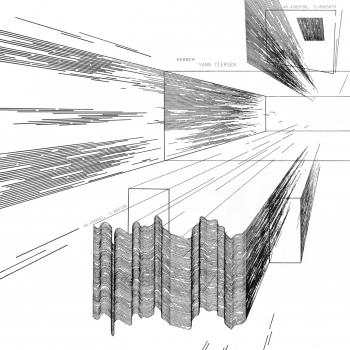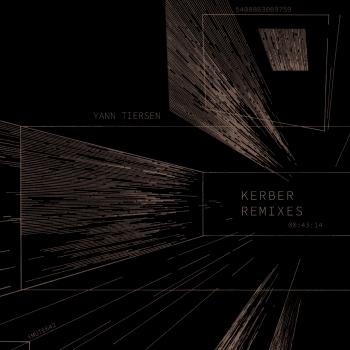
Ker Yegu Yann Tiersen
Album info
Album-Release:
2021
HRA-Release:
05.08.2021
Label: Mute
Genre: Classical
Subgenre: Classical Crossover
Artist: Yann Tiersen
Composer: Yann Tiersen (b. 1970)
Album including Album cover
- Yann Tiersen (b. 1970):
- 1 Tiersen: Ker Yegu 04:35
- 2 Tiersen: Poull Bojer 06:09
- 3 Tiersen: Ker al Loch 06:50
- 4 Tiersen: Poull Bojer (Edit) 04:18
- 5 Tiersen: Ker al Loch (Edit) 04:07
Info for Ker Yegu
Weihl explains, “Using the abstracted geographical imagery created by Katy Ann Gilmore [the artist behind the album’s artwork] as a starting point, and further referencing the coast line of Ushant and the natural world, we created imagery (ranging from fantastical re-imagines of landscape, seas and atmospheric conditions to the processes in micro biology and chemical reaction) to capture the beauty and scale of Tiersen’s composition.”
The follow up to 2019’s Portrait (acollection of 25 newly recorded tracks from throughout his career), Kerber is very much a new chapter in the Breton artist’s work, one that begins with his most overtly electronic material to date. True to Tiersen’s nuanced and subtle approach, this isn’t a U-turn-like thumping piece of dance music but instead a beautifully textured, highly immersive and thoughtfully constructed electronic world to step inside of.
It is both an evolution of what has come before, as well as a new space to explore. On the new album, the piano is the source, but electronics are the environment that they exist within. Tiersen explains, “You may get this intuitive thinking of, ‘oh it’s piano stuff’, but actually it’s not. I worked on piano tracks to begin with but that’s not the core of it, they are not important. The context is the most important thing – the piano was a precursor to create something for the electronics to work around.”
Working in The Eskal, the studio he built on Ushant (the island where he lives, located 30 kilometres off the West coast of Brittany in the Celtic Sea), Tiersen’s process for the album’s recording was particularly involved. After spending the spring writing the piano parts, he went on to spend that summer meticulously creating a sample bank for the Elektron Octatrack using these parts as inspiration, following the chord progressions, playing them on instruments such as the Ondes Martenot, mellotron and harpsichord. These were then subsequently transformed, reshaped and processed. What then followed, with producer Gareth Jones (Depeche Mode, Einstürzende Neubauten), was three weeks of working with electronics, sampling, re-sampling and processing sounds to create an engulfing soundscape where the tender tones of piano keys merge with gently pulsing electronics and an intense ambient milieu.
A sense of place has often been a central theme in Tiersen’s work and here that is no different. Kerber is named after a chapel in a small village on the island and each track is tied to a place mapping out the immediate landscape that surrounds Tiersen’s home.
Yann Tiersen is planning a live event to be broadcast worldwide from Ushant (with extensive touring to follow) and the island is further represented on the graphic artwork by LA-based artist, Katy Ann Gilmore who explains,“Also inspired by landscape, I’m drawn to simple, repeated elements to convey the idea of depth and perspective. I think about lines receding to infinity, and how that helps build up the world around us. Using maps of locations indicated by Yann, I traced shorelines, fences, and other place markers that tie to the specific tracks. I then used these marks to build up shapes that inhabit a new geography as they move through space towards infinity.”
Kerber’s release will be preceded by a book of sheet music on 20 July. Exclusively published by Hal Leonard, the folio will feature all seven pieces presented for Solo Piano, with preface by Tiersen.
Yann Tiersen
Yann Tiersen
Breton-born artist Yann Tiersen has been involved in music for most of his life.
He started learning piano at the age of four, took up violin at the age of six and received classical training at musical academies in Rennes, Nantes and Boulogne. Then, at the age of 13, he chose to alter his destiny, breaking his violin into pieces, buying a guitar and forming a rock band.
Growing up in Rennes gave Tiersen the perfect musical education in the form of the city’s annual Transmusicales festival, seeing acts like Nirvana, Einstürzende Neubaten, Nick Cave and The Bad Seeds, The Cramps, Television and Suicide. When his band broke up a few years later, instead of hunting for some new musicians, he bought a cheap mixing desk, an eight-track reel to reel, and started recording music solo with a synth, sampler and drum machine, poring over the grooves of old records on the hunt for loops and orchestral strings to plunder.
“One day I thought, instead of spending days on research and listening to tons of records to find the nearest sound of what I have in mind, why don’t I fix this fucking violin and use it?” Through the summer of 1993, Tiersen stayed in his apartment, recording music alone with guitar, violin and accordion, guided not by the classical canon, but by intuition and his vision of “a musical anarchy”.
By the end of the summer of 1993, Tiersen had recorded over 40 tracks, which would form the bulk of his first two albums. 1995’s La Valse Des Monstres, inspired by Tod Browning’s Freaks and Yukio Mishima’s The Damask Drum, was followed six months later by Rue Des Cascades, a collection of short pieces recorded with toy piano, harpsichord, violin, accordion and mandolin. Six years later, the record would find a much larger audience when several tracks, along with music from Le Phare, would be used on the soundtrack to Jean-Pierre Jeunet’s film Amelie (2001).
Tiersen’s commercial breakthrough would come earlier, though, and off his own back. 1998’s Le Phare (The Light House) was recorded in self-imposed seclusion on the isle of Ushant (located 30 kilometres off the west coast of Brittany in the Celtic Sea), where Tiersen spent two months living in a rented house. At night, he watched the Creach’h, the most powerful lighthouse in Europe, as it illuminated the surrounding scenery.
Le Phare went on to sell over 160,000 copies, confirming Tiersen’s status as one of the most pioneering and original artists of his generation and commencing a run of successful albums like 2001’s L'Absente (featuring orchestral group Synaxis, Lisa Germano and the Divine Comedy’s Neil Hannon) and 2005’s Les Retrouvailles (with guests Stuart Staples of Tindersticks, Jane Birkin and Elizabeth Fraser of Cocteau Twins). In this period, Tiersen also took his music out around the world, playing shows with a full orchestra and an amplified string quartet – a set-up captured on 2002’s electrifying live album C'etait ici. Tiersen then went on to create scores for the likes of Wolfgang Becker’s tragicomedy Good Bye Lenin! (2003) and Tabarly (2008), a documentary about the French sailor Éric Tabarly, who ate his final meal on Ushant before meeting a watery end in the Irish sea.
In 2010 he signed to Mute and released the first of a series of album with more of a band presentation. Dust Lane introduced synthesisers to his recordings, “I have always tried to incorporate vintage electronic sounds that I liked in my music but for the exception of the [early electronic keyboard] Ondes Martenot, it never happened until Dust Lane.” The Ken Thomas produced album Skyline (2011) followed, continuing his collaborative work with appearances from Ólavur Jákupsson, Peter Broderick and Efterklang, to name but a few and in 2014 he released Infinity (2014), an album that built upon toy piano recordings, electronically manipulated to provide a base for the rest of the instrumentation, “a constant back and forth from acoustic to electronic to electric to digital, back to analogue. Then all back the other way.”
2016 saw Tiersen’s first solo piano release, EUSA, a move into more minimalist contemporary sounds showing the continuation of Tiersen’s diversity. The album gave a musical map of Ushant, the island he has called home for the past several years, with electronically manipulated original field recordings of the natural sounds on the island creating subtle drone that runs throughout. This was followed in 2019 by ALL, recorded at his newly built studio on Ushant, an album that further explores our connection with nature, place and his love of language.
In 2019, he revisited some of his catalogue with a collection of 25 newly recorded tracks from throughout his career. Portrait featured collaborations with John Grant, Gruff Rhys from Super Furry Animals, Stephen O’Malley from Sunn O))), and Blonde Redhead.
Portrait gave Tiersen a chance to open a new chapter in his work with Kerber (2021), his most overtly electronic material to date. True to Tiersen’s nuanced and subtle approach, this isn’t a U-turn-like thumping piece of dance music but instead a beautifully textured, highly immersive and thoughtfully constructed electronic world to step inside of.
It is both an evolution of what has come before, as well as a new space to explore. On the new album, the piano is the source, but electronics are the environment that they exist within. Tiersen explains, “You may get this intuitive thinking of, ‘oh it's piano stuff’, but actually it's not. I worked on piano tracks to begin with but that's not the core of it, they are not important. The context is the most important thing - the piano was a precursor to create something for the electronics to work around.”
This album contains no booklet.










